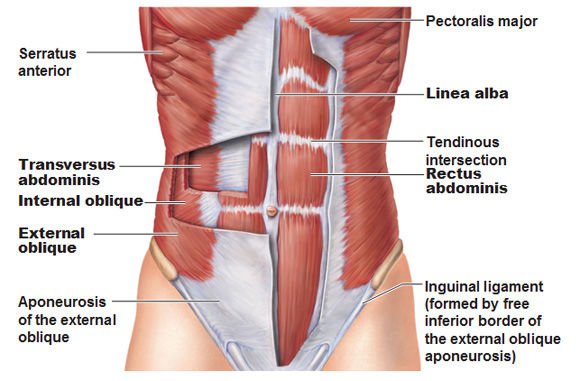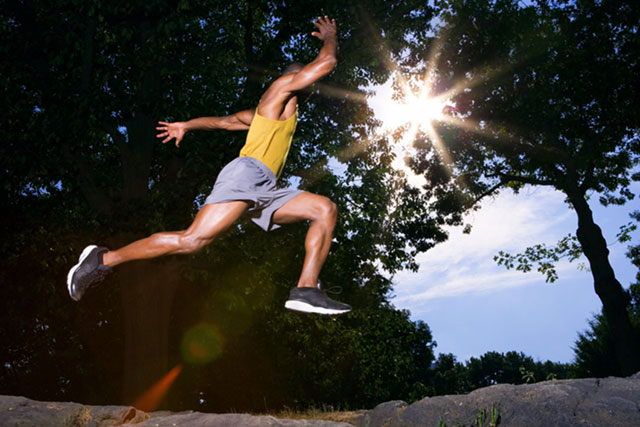Fueling Tips for Single and Double Workouts As one coach aptly stated, “Too many athletes show up for training, but they don’t show up for meals. They might as well not show…

A abdominal muscle strain is fairly common in athletes and active populations because this group of the pulled abdominal muscle is constantly engaged to keep the athlete’s core tight so that the athlete can perform and execute skills using his/her extremities and/or total body. Strong and healthy abdominal muscles only enhance an athlete’s performance. However, injure these muscles, and the athlete will have significant difficulty trying to perform. The muscles of the abdomen are layered from deep to superficial including the transverse abdominis (fibers run across the abdomen), internal and external obliques (fibers run in opposite diagonal directions), and rectus abdominis (fibers run up and down). Each has a function linked to its structure.  The deepest muscle, transverse abdominis constricts to hold the abdominal contents in place and to help with forced expiration, coughing, laughing, and sneezing. The internal and external obliques’ diagonal fibers are designed to assist in trunk rotation, lateral flexion (movement sideways), and when working as a pair, trunk flexion. The most superficial muscle group is the rectus abdominis. This is the set of muscles that fun up and down the abdomen and can be seen in athletes who have a low body fat (also known as the much sought after “six pack”). The muscle fibers can be seen just under the skin as they rise and fall from their attached fascial sheath. The rectus abdominis is primarily responsible for trunk flexion, but can also assist in other trunk movements.
The deepest muscle, transverse abdominis constricts to hold the abdominal contents in place and to help with forced expiration, coughing, laughing, and sneezing. The internal and external obliques’ diagonal fibers are designed to assist in trunk rotation, lateral flexion (movement sideways), and when working as a pair, trunk flexion. The most superficial muscle group is the rectus abdominis. This is the set of muscles that fun up and down the abdomen and can be seen in athletes who have a low body fat (also known as the much sought after “six pack”). The muscle fibers can be seen just under the skin as they rise and fall from their attached fascial sheath. The rectus abdominis is primarily responsible for trunk flexion, but can also assist in other trunk movements.
A strain is an injury to a muscle. A strain can vary in severity from a mild stretch to a full rupture. In an abdominal muscle strain, any one of the four muscles can be injured causing extreme discomfort with any trunk movements as well as with coughing, laughing, deep breathing, or sneezing.
First Degree Abdominal Muscle Strain– A mild stretching of a muscle is diagnosed as a first degree abdominal strain and can result in localized pain, mild swelling, and pain with movement, coughing, laughing, deep breathing, or sneezing.
Second Degree Abdominal Muscle Strain – A more severe injury of an abdominal muscle is a partial tear or (second degree). Depending on the number of fibers torn, this type of injury may be quite debilitating for the athlete. The athlete may experience sudden abdominal pain, marked tenderness, localized swelling, and discoloration. Any and all movements of the athlete may be painful with the athlete guarded in his/her movements.
Third Degree Abdominal Muscle Strain – A third degree muscle strain is the most severe injury and is diagnosed as a complete muscle rupture either at its insertion, origin, or midsection. Along with the symptoms of a second degree muscle strain, the athlete may also experience the symptoms of shock including nausea, vomiting, pale skin, excess perspiration, difficulty breathing, and a shallow and rapid heart rate. Athletes suspected of a full rupture muscle tear should be immediately removed from the activity and provided emergency medical care until emergency services arrive. The athlete should be kept still while an ice pack is applied to the injury. The athlete’s vital signs (pulse, respiration, blood pressure) should be monitored until help arrives.
An abdominal strain is easily diagnosed by a sports medicine professional with the use of a thorough medical history and complete clinical evaluation. Palpation of the injury site combined with abdominal muscle tests can provide enough information to determine the severity of the abdominal muscle injury as well as the specific muscle injured.
Athletes more susceptible to an abdominal strain are those in sports that require strong rotational movements or flexion/hyperextension movements. They are usually acute (traumatic) injuries seen in athletes in the sports of baseball, softball, basketball, gymnastics, and track and field.
The most common causes of abdominal strains are sudden twisting (i.e., swinging a bat) or sudden hyperextension of the spine (i.e., as seen during dynamic gymnastics movements) (Anderson, M.K., Hall, S.J., & Martin, M., 2005). If the force of the movement is stronger than the fibers of the muscles can withstand, the muscle will begin to stretch. If the force continues, the fibers may begin to tear. Continued force could cause a complete rupture within the muscle or between the muscle and its fascial attachment.
Athletes can prevent abdominal muscle strains by maintaining the flexibility of their trunk and increasing the strength of their core muscles. The good thing is that many sports programs already include core strength training exercises as part of their conditioning program. If athletes are involved in programs that do not incorporate core training, a large variety of these types of exercises are used by personal trainers, physical therapists, and certified athletic trainers. These professionals can be consulted for additional or advanced exercises to strengthen core muscles. Here are a few good at home abdominal exercises.
The Bridge – Is a core exercise that can be done without equipment. It is easily performed and has a lot of variations that can be added to increase the difficulty level of the specific exercise.
The Plank – is another good exercise to build core muscles and is performed on the ground with the athlete on his/her forearms in a push-up position. If this is too difficult, the athlete may start in the plank position on his/her knees.
The Side Plank – Is another alternative to the regular plank. The idea is the same but the athlete is in a side lying position. The athlete balances on one forearm while holding his/her opposite arm up in the air keeping the body straight with only the feet touching the ground. A more difficult variation of the side plank is to have the athlete lift his/her top leg and hold it while maintaining a tight core in the plank position. This can be done with multiple leg lifts or by just holding the leg lift for a number of seconds.
The Traverse Ab Press – This exercise is demonstrated in the following SportsMD Video
Immediate treatment – Involves using the P.R.I.C.E. principle – Protection, Rest, Icing, Compression, Elevation -beginning with the application of a cold therapy pad or ice pack that can be used for your stomach for twenty minutes. The ice pack can be reapplied every two hours for the first two to three days post-injury. Rest is another component of the P.R.I.C.E. principle but is a little more difficult with an abdominal strain. Injuries to the arms or legs can easily be protected and rested through the use of crutches, slings, or braces. However, splinting the trunk of the body is not such an easy task.
Limit Activities – To protect and rest the abdominal muscles, the athlete may need to limit his/her activities for a few days until the pain decreases.
Wear a Stomach Compression Pad– To assist the athlete in supporting the injured area, the athlete may choose to wear an stomach compression pad. The pad also serves to add compression to the area minimizing any swelling.
Mild Stretching – After the pain begins to subside, the athlete can begin mild stretching of the injured area along with isometric contractions to begin to strengthen and heal the injured tissue. Stretching should proceed slowly and be performed carefully so as not to cause any pain. Pain is an indicator that the athlete has exceeded the injured tissue’s capability to lengthen.
Stretching too early during the rehabilitation of a muscle strain can reinjure the damaged tissue and set the athlete’s progress back. New collagen tissue can be torn from its attachment and restart the bleeding and swelling process.
Isometric muscle exercises – Can be safely performed early in the rehabilitation process because they are designed to contract a muscle without allowing any movement of the associated joints. One such exercise is to have the athlete lie on his/her back and flex his/her knees placing his/her feet on the ground. The athlete then pushes his/her lower back against the ground while contracting all of the abdominal muscles at the same time. The athlete can hold the contraction for 10 seconds and repeat 10 times. As the muscle continues to heal and the athlete’s range-of-motion improves, the athlete can progress to concentric muscle exercises for his/her core.
Concentric muscle exercises – Are exercises in which the muscle contracts causing a shortening of the muscle and movement of the adjacent joints. Movements to improve the strengths of all of the abdominal muscle groups should include the movements of trunk flexion, rotation, and lateral flexion (side bend). Each exercise should be done to target specific muscle groups. Although once popular to strengthen the rectus abdominis, sit-ups are not the best exercise for strengthening the abdominals. An effective exercise is a modified crunch. The athlete lies on the floor with his/her knees bent and feet placed shoulder width apart. The athlete contracts his/her abdominals and then lifts his/her chin to the ceiling focusing on moving the chest off of the floor. It is a lift rather than a curl. The internal and external obliques can be targeted by using the same exercise as above, but by adding a rotational component with each lift. The athlete can alternate rotations to the left and to the right with each modified crunch. This rotational component targets the diagonal fibers of the internal and external obliques. Traditional core exercises can also be performed to strengthen the abdominal muscles. If available, core exercises can also be performed using a therapy ball or foam roll.
 Telehealth appointments or Second Opinions with a top orthopedic doctor is a way to learn about what’s causing your pain and getting a treatment plan. SportsMD’s Telehealth and Second Opinion Service gives you the same level of orthopedic care provided to top professional athletes! All from the comfort of your home.. Learn more via SportsMD’s Telemedicine and Second Opinion Service.
Telehealth appointments or Second Opinions with a top orthopedic doctor is a way to learn about what’s causing your pain and getting a treatment plan. SportsMD’s Telehealth and Second Opinion Service gives you the same level of orthopedic care provided to top professional athletes! All from the comfort of your home.. Learn more via SportsMD’s Telemedicine and Second Opinion Service.
This a great video on how to treat an abdominal muscle strain.
Once the athlete has pain-free full range-of-motion of his/her trunk (flexion, extension, rotation, and lateral flexion) and good strength, the athlete is ready to progress to sport specific functional exercises.
These exercises should include a gradual progression of skills required in the athlete’s sport. For example, a softball player should include both offensive and defensive skills specific to the athlete’s position. For example, a catcher should include drills specific to that position whereas an athlete who competes as a middle infielder should include drills fielding balls directly at the athlete as well as to either side. Regardless of the defensive position, all ballplayers need to be able to swing a bat.
Those returning from an abdominal strain should take extra care when beginning and progressing through hitting drills. The athlete should begin swinging drills at about an intensity of 50% while using a lighter bat than usual.
Once the athlete can perform bat swings at full speed without pain, the athlete can progress to hitting whiffle balls off of a tee or soft toss drills. Once the athlete can perform these drills comfortably and with confidence, the athlete can proceed to hit off of a machine.
Only when the athlete can comfortably perform all the basic skills of his/her sport without pain can the athlete progress to scrimmage situations. With time and confidence, the athlete will be ready to return to sports.
The athlete can return to sports when he/she has been released by his/her physician and is pain-free through all ranges-of-motion of the trunk with full strength.
Question: What does an abdominal muscle strain feel like?
Answer: An abdominal muscle will feel sore or painful and and it will restrict your movement. You may feel sharp pain, tenderness and you may have swelling and bruising around the injured area.
Question: How do I know if I strained my abdominal muscle?
Answer: You will know that you have a strained abdominal muscle as there will be pain that ranges from mild discomfort to sharp pain and may include muscle spasms and bruising.
Question: How long does a strained abdominal muscle take to heal?
Answer: Like any other muscle strain, it depends on the severity of your injury, along with your age and your willingness to follow proper recover ptotocols. Grade I muscle strains take about 2-4 weeks to heal. Grade II abdominal muscle strrains take about 2 months to recover fully. If you experience a grade III strain, healing time depends on the type of surgery you receive and could take anywhere from 6 to 9 months or longer.
Question: Is abdominal strain serious?
Answer: An abdominal strain can be mild or serious depending on the severity of the injury. Grade I strains can be treated at home but Grade III strains need immediate medical attention. It’s best to visit a medical provider to understand if there a tear or rupture.
Matt Henry will return home with other members of the Test Squad not taking part in the ODI Series against Pakistan after suffering an abdominal strain on Day 5 of the 2nd Test in Karachi. A replacement in the ODI Squad to face Pakistan and India will be confirmed soon. #PAKvNZ pic.twitter.com/DmzEIDcgJa
— BLACKCAPS (@BLACKCAPS) January 7, 2023
Novak Djokovic Fears He May Withdraw From Australian Open As He Suffers Stomach Injury During Third-Round Victoryhttps://t.co/85ejMeOoAr
— Moji Sensei Delano (@MojiDelanoBlog) February 12, 2021
References

Fueling Tips for Single and Double Workouts As one coach aptly stated, “Too many athletes show up for training, but they don’t show up for meals. They might as well not show…

Author Nancy Clark MS RD CSSD Sugar, Health & Athletic Performance Of all the questions athletes ask me, “Is sugar bad for athletes…?” is at the top of the list. You likely…

Author Kristen Carli, MS, RD Choosing the right protein source to support your fitness goals and overall health is important. With so many protein supplements available, it’s hard to know which one…

Athletes tend to do a good job of training their muscles, heart and lungs. But some of them (particularly endurance athletes and those in running sports) commonly fail to train their gut.…

Some people try so hard to not eat it, but they inevitably succumb, and inevitably feel guilty. If you share the same love-hate relationship with chocolate, keep reading. And be thankful this so-called…